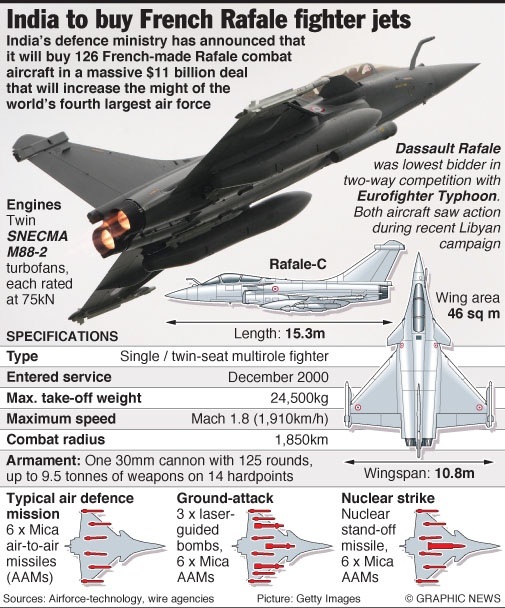Why in news?
The Defence Minister refused to share the price details on Rafale purchase, citing the Security Agreement provisions.
What is the Rafale aircraft?
- Rafale is a twin-engine medium multi-role combat aircraft.
- It is manufactured by the French company Dassault Aviation.
- Dassault claims Rafale has 'Omnirole'.
- This is the capability to perform several actions at the same time.
- Rafale can carry out both air-to-ground as well as air-to-air attacks.
- It can also carry out interceptions during the same flight.
- The aircraft is fitted with an on-board oxygen generation system (OBOGS).
- It suppresses the need for liquid oxygen re-filling or ground support for oxygen production.

How did the deal evolve?
- Indian Air Force (IAF) raised the requirement for Medium Multi Role Combat Aircraft (MMRCA) in 2007.
- This was to replace the aging fleet of MiG aircratfs.
- Tender - Tenders for 126 Medium Multi Role Combat Aircraft (MMRCA) fighters were issued by India in 2007.
- It was an open competition between companies including Dasault Aviation of France.
- Dassault was announced as the lowest bidder in 2012.
- Earlier Deal - Of the 126 jets required, 18 fighters were to be imported in a fly-away condition.
- Hindustan Aeronautics Ltd (HAL) would manufacture the remaining 108 jets.
- This was agreed to be with Transfer of Technology (ToT) from Dassault.
- Stall - India and France were unable to decide on a price for the jets.
- The workshare agreement between HAL and Dassault Aviation was signed in 2014.
- But with the new NDA government in place, clarity on the progress of the deal remained unclear.
- New deal - On PM's visit to France in 2015, India’s intention to buy 36 Rafale aircraft in “fly-away” condition was announced.
- Defence Minister announced the previous 126 fighter jet deal to be dead.
- Subsequently, the deal for the acquisition of 36 aircraft was signed by the Defence Ministers of India and France in 2016.
- This was done through a government-to-government deal.
What are the present concerns?
- ToT - The current deal has a 50% offset component.
- Accordingly, Dassault will manufacture items worth 50% of the deal in India.
- However, the absence of transfer of technology (ToT) component is raised as an issue.
- Also, no role is guaranteed for any Indian public sector company, including HAL.
- Deal - The present deal as direct government-to-government agreement, as against the earlier open tender, is criticised.
- Also, the 36 fighters are said to be purchased at a much higher price than earlier negotiated.
What is the dispute with sharing price details?
- Earlier deal - The previous government's price for 126 aircraft was never finalised, and no contract was signed or executed.
- Hence, no official figure on the price was ever given.
- New Deal - Recently, the Defence Minister declined to share the cost of the Rafale fighters under the new deal, with Rajya Sabha.
- It was said that the price details were "classified information".
- This was as per the Inter-Governmental Agreement (IGA) between the Governments of India and France.
- Accordingly, material exchanged under IGA is governed by the provisions of the Security Agreement.
- However, in 2016, Minister of State for Defence had shared the price in the Lok Sabha in a written reply.
- The basic price of each Rafale aircraft was said to be around Rs 670 crore.
- At the time of its signing, the 36-aircraft deal was said to be worth around Rs 59,000 crore.
What is the Security Agreement?
- Security - Signed between the two nations in 2008, it has some confidentiality provisions.
- It relates to Protection of Classified Information and Material in the field of Defence.
- For any contract or sub-contracting contract with classified information and material, a security annex shall be drawn up.
- The competent security authority from the information forwarding party shall specify what has to be protected by the receiving party.
- Renewal - It was specified that the Agreement shall remain in force for a period of 10 years.
- It shall be renewed by "tacit consent" for new 5-year period.
- Accordingly, the agreement will continue unless one of the Parties notifies its intention to not renew.
- This has to be given in writing 6 months prior to the end of the current period of validity.
- The initial 10-year life of the Agreement signed in 2008, ended on January 24, 2018.
- It is not clear if it has been renewed by tacit consent by the government.
What is the parliamentary procedure?
- It has generally been the practice to share the cost of defence deals with Parliament.
- However, in some cases, the details have been kept secret for reasons of national security.
- Nevertheless, the government is duty-bound to share the pricing details with Comptroller and Auditor General (CAG) and the Public Accounts Committee (PAC) of Parliament.
Source: The Indian Express
